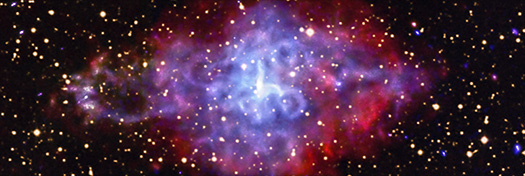For Release: June 20, 2024
NASA/CXC

Credit: X-ray: NASA/CXC/ICE-CSIC/A. Marino et al.; Optical: SDSS; Image Processing: NASA/CXC/SAO/J. Major
Press Image, Caption, and Videos
Astronomers have taken an important step toward understanding some of the densest and strangest objects in the Universe by using NASA’s Chandra X-ray Observatory. These results show that the interiors of neutron stars may contain a special type of ultra-dense matter that does not exist anywhere else in the universe.
Neutron stars are the dense cores that can form after massive stars collapse. They are so dense that a teaspoon of their matter weighs about a trillion pounds.
For many years, scientists have wanted to investigate the nature of matter in neutron stars, including basic properties such as the pressures and temperatures in different parts of their interiors. They refer to this as understanding the neutron star’s “equation of state”.
Now, data from Chandra and ESA’s XMM-Newton of a sample of 70 young neutron stars are providing new clues. Specifically, these X-ray data are showing how quickly the surfaces of these neutron stars are cooling over time and what information that gives about the matter within.
The team capitalized on the location of some of these neutron stars in supernova remnants, the debris fields from the exploded stars that created them. Estimates of the ages of the supernova remnants gave them the ages of the neutron stars.
“Three of these neutron stars are much cooler than the others at similar ages,” said Alessio Marino, of the Institute of Space Sciences (ICE) in Barcelona Spain, author of a paper in Nature Astronomy describing the results. “This was a big clue that something weird might be going on inside these objects, which we need to understand.”
The team thinks that part of the explanation for the rapid cooling is that these neutron stars are more massive than most of the rest.
“Because more massive neutron stars have more particles, special processes that cause neutron stars to cool more rapidly might be triggered,” said co-author Clara Dehman, also of ICE. “It’s like having early answers filled in on a crossword puzzle — it makes filling in the rest of the answers much easier.”
In this case the “crossword puzzle” is so complex, however, that the authors turned to machine learning, a type of artificial intelligence, to compare the data to different equations of state. Their results imply that about 75% of the equations of state — the ones that do not include the capability for rapid cooling at higher masses — can be ruled out.
“If we are able to eliminate some of the possibilities about what is inside a neutron star,” said co-author Konstantinos Kovlakas of ICE, “then the next question we have to ask is, what is left?”
One possibility is a type of radioactive decay near the center of neutron stars where neutrinos — low mass particles that easily travel through matter — carry away much of the energy and heat, causing rapid cooling.
Another idea is that there are individual quarks inside at least some neutron stars. Quarks are fundamental particles that are not usually found in isolation. Most of the visible matter in the universe is composed of protons and neutrons, and both of these particles contain three quarks.
Another type of exotic matter is one where particles are not mostly protons and neutrons but are dominated by another type of particle called a meson, composed of a quark and an oppositely charged quark. These particles are usually very short-lived, lasting less than a billionth of a second, but in the special conditions in the center of a neutron star they could last much longer.
“We cannot say with certainty what is inside of these neutron stars, but these latest data are telling us that something exotic may be needed,” said co-author Nanda Rea of ICE. “Understanding the structure and properties of neutron stars might be crucial for other fields of astrophysics, such as interpreting the bursts of gravitational waves when they merge.”
The exceptionally cool three neutron stars are PSR J0205+6449, PSR B2334+61 and CXOU J0852−4617 (PSR J0205, PSR B2334 and CXOU J0852 for short). PSR J0205 is in the supernova remnant 3C 58, PSR B2335 in SNR G114.3+0.3 and CXOU J0852 in SNR Vela Jr.
The Nature Astronomy paper describing these results is available here. Other authors of the paper besides Marino, Dehman, Kovlakas and Rea are J. A. Pons from the University of Alicante in Spain, and Daniele Viganò from ICE.
NASA's Marshall Space Flight Center manages the Chandra program. The Smithsonian Astrophysical Observatory's Chandra X-ray Center controls science from Cambridge Massachusetts and flight operations from Burlington, Massachusetts.
Media Contact:
Megan Watzke
Chandra X-ray Center, Cambridge, Massachusetts
617-496-7998
mwatzke@cfa.harvard.edu
Jonathan Deal
Marshall Space Flight Center, Huntsville, Alabama
256-544-0034
jonathan.e.deal@nasa.gov


